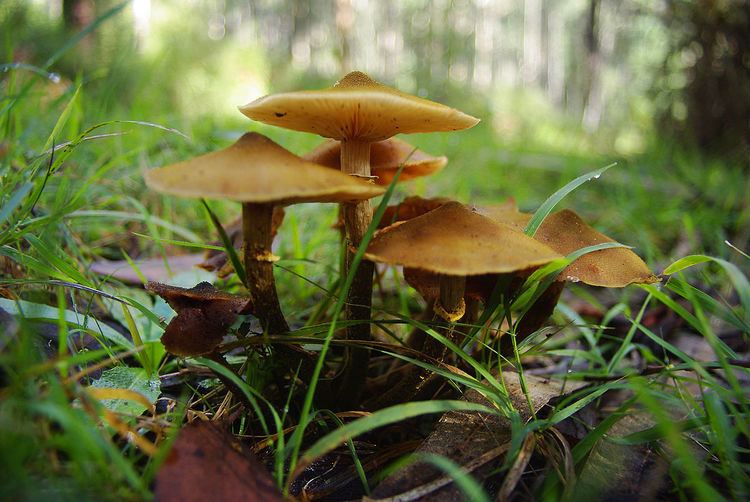Hosts Several tree species | ||
 | ||
Causal agents Several species of the genus Armillaria | ||
Armillaria root rot is a fungal root rot caused by several different members of the genus Armillaria. The symptoms are variable depending on the host infected, ranging from stunted leaves to chlorotic needles and dieback of twigs and branches. However, all infected hosts display symptoms characteristic of being infected by a white rotting fungus. The most effective ways of management focus on limiting the spread of the fungus, planting resistant species, and removing infected material. This disease poses a threat to the lumber industry as well as affecting recreational areas.
Contents
Hosts and symptoms
Because this disease is caused by multiple species within the genus Armillaria, it has an extremely broad host range. Hundreds of trees and shrubs are susceptible to root rot to varying degrees. In fact, the only two genera of tree known to be resistant to Armillaria root rot are larch and birch. Further investigation is being conducted for additional species, but at this time there is no further evidence leading to the belief that more exist.
As a result of the multitude of possible hosts, symptoms also range a great deal from one infection to another. All infected hosts do however display symptoms common to white rotting fungi. These include light or bleached wood as a result of the degradation of essential cell wall compounds such as lignin and hemicellulose. In addition to these, the host will show above-ground symptoms due to fungal infection of the vasculature. These include chlorosis in the needles as well as dieback of twigs and branches. The extent of these symptoms varies with the degree of infection as well as the susceptibility of the host. In addition to these symptoms, the trunks of conifers will also exude excess resin in a process known as resinopsis which results in a layer of resin, debris, and fungal tissue forming around infected roots. Deciduous trees occasionally develop sunken cankers but most often fail to exhibit these symptoms on the trunk, and will instead simply display the other symptoms.
In addition to these symptoms, signs of the infectious organism are very evident in the host. Upon removal of the bark, white mycelial mats are visible along with rhizomorphs, a distinctive reproductive structure. Clusters of mushrooms will also form at the base of the infected tree, indicating an infection. Also, zone lines of melanized fungal cells may be visible within infected wood.
Disease cycle
For the most part, this fungus exhibits a life cycle characteristic of basidiomycetes. It reproduces sexually with the mating of hyphae and produces a basidiocarp at the base of the infected host. This basidiocarp produces basidiospores that will further infect new hosts. However, Armillaria rarely spreads using this method in nature, possibly as a result of the spores being ineffective. In contrast, it will spread either through rhizomorphs or direct mycelial contact. In the case of mycelial contact, the roots of an infected host grow near enough to a new host that mycelia simply grow onto the new host and infect. Rhizomorphs are string-like masses of hyphae utilized if no new hosts are nearby and spread by probing through the soil towards uninfected roots.
Environment
Armillaria infects trees in temperate and tropical regions. Armillaria commonly infects stressed trees that have been weakened by insects, other pathogens and/or climate stresses. It can also kill healthy trees especially in dry areas, like coniferous forests in the western United States. This fungus is found worldwide, but prefers cool soils and climates.
Management
Plant varieties that are resistant to Armillaria or species are resistant to other environmental or biological stressors. If the infected area has been cleared of trees, plants that are not vulnerable to the disease should be planted for five or so years until Armillaria is eradicated. Stump removal is also an effective management tool but can be expensive. Another way to reduce susceptibility is to maintain plant health by regular fertilization (if needed), watering during droughts, and trying not to create wounds on the plant. Fumigation can also be used to reduce the amount of inoculum.
Importance
This disease poses a serious threat to the timber industry in that it affects nearly every cultivated species of hardwood and proves very difficult to remove once it has entered an area. The ability to spread using rhizomorphs as well as through mycelial contact allow the fungus to spread over very large areas and between many individuals. In fact, Armillaria is recognized as the largest living organism due to its clonal method of spreading. Infection is especially strong where environmental conditions are optimal and a large amount of possible hosts exist. This essentially is anywhere hardwoods are found growing. It has been found in every state in the United States of America as well as on several other continents including Australia, Europe, and Asia.
